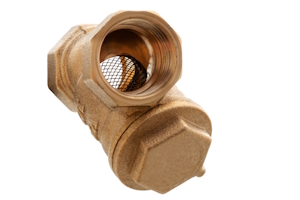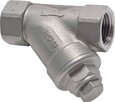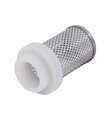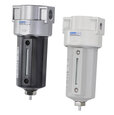How To Select Filter & Strainer Mesh Size

Figure 1: Y strainer with view of mesh within
Mesh refers to the number of openings per inch in a filter or strainer, which determines the size of particles that can pass through. Selecting the correct filter and strainer mesh size is crucial to prevent operational issues such as high pressure drop. In the United States, mesh size is the standard measurement used, while in the rest of the world, filter size is typically measured in microns. This article provides guidance on how to convert between mesh size and filter size and the issues that can arise if these are not carefully selected.
Table of contents
- Micron size and mesh size
- Micron-to-mesh conversion chart
- Strainer and filter types
- Improperly sized strainers and filters
- FAQs
View our online selection of strainers and filters!
Micron size and mesh size
A strainer cannot function properly without an appropriately sized mesh filter. Micron and mesh size describe the size of the openings in the strainer through which debris passes. Though these are two different measurements, they describe the same thing.
What is a micron?
A filter's size is measured in microns. A micron (micrometer) is a unit of length used to measure tiny particles. On a scale of one-thousandth of a millimeter, it is about one 25-thousandth of an inch.
What is mesh size?
A strainer's mesh size indicates how many openings there are in the mesh across one linear inch. The ratings typically range from a size 3 mesh screen with 6,730 microns to a size 400 mesh screen with 37 microns.
Micron-to-mesh conversion chart
Table 1: Converting between micron and mesh size
| Mesh size | Filter size (microns) | Millimeters | Inches |
| 10 | 2000 | 2.000 | 0.079 |
| 12 | 1680 | 1.680 | 0.066 |
| 14 | 1410 | 1.410 | 0.056 |
| 16 | 1190 | 1.190 | 0.047 |
| 18 | 1000 | 1.000 | 0.039 |
| 20 | 841 | 0.841 | 0.033 |
| 25 | 707 | 0.707 | 0.028 |
| 30 | 595 | 0.595 | 0.023 |
| 35 | 500 | 0.500 | 0.020 |
| 40 | 420 | 0.420 | 0.017 |
| 45 | 354 | 0.354 | 0.014 |
| 50 | 297 | 0.297 | 0.012 |
| 60 | 250 | 0.250 | 0.010 |
| 70 | 210 | 0.210 | 0.008 |
| 80 | 177 | 0.177 | 0.007 |
| 100 | 149 | 0.149 | 0.006 |
| 120 | 125 | 0.125 | 0.005 |
| 140 | 105 | 0.105 | 0.004 |
| 170 | 88 | 0.088 | 0.004 |
| 200 | 74 | 0.074 | 0.003 |
| 230 | 63 | 0.063 | 0.002 |
| 270 | 53 | 0.053 | 0.002 |
| 325 | 44 | 0.044 | 0.002 |
| 400 | 37 | 0.037 | 0.002 |
| 500 | 25 | 0.025 | 0.00099 |
| 625 | 20 | 0.020 | 0.00079 |
| 1250 | 10 | 0.010 | 0.000394 |
| 1750 | 8 | 0.008 | 0.000315 |
| 2500 | 5 | 0.005 | 0.000197 |
| 5000 | 2.5 | 0.0025 | 0.000099 |
| 12000 | 1 | 0.001 | 0.0000394 |
Mesh sizes of specific particles
Because it can be difficult to conceptualize microns and mesh size, Table 2 provides helpful examples of common particles.
Table 2: Mesh sizes of particular particles
| Mesh size | Filter size (microns) | Example of particle size |
| 14 | 1410 | - |
| 28 | 700 | Beach sand |
| 60 | 250 | Fine sand |
| 100 | 149 | - |
| 200 | 74 | Portland cement |
| 325 | 44 | Silt |
| 400 | 37 | Plant pollen |
Strainer and filter types
Y strainers are typically used for inline applications with horizontal flow directions. The Y-shaped design is optimized to minimize flow resistance, enabling efficient debris collection and simplifying maintenance.
Suction strainers are specifically designed for applications where the flow is drawn from a reservoir or tank, typically in a vertical direction. Read our types of pipeline strainers article for more information.
Pneumatic filters are often found in FRL units but can be used on their own. These filters remove contaminants like moisture and oil from compressed air to ensure cleanliness in industrial applications.

Figure 2: Y strainer (left), suction strainer (middle), and pneumatic filter (right).
Improperly sized strainers and filters
Care must be taken to not undersize or oversize the mesh when choosing a strainer or filter.
-
Undersized
- Pressure drop across the filter will be higher than necessary
- Cleaning will be more frequent
- Thinner metal to create the mesh strings meaning the filter can handle less pressure differential
-
Oversized
- The strainer or filter will not effectively remove the desired particles from the media
Step-by-step guide to selecting mesh size
Step 1: Identify the primary contaminants
- Analyze the media: Start by looking at what will go through the filter or strainer. This could be a liquid, gas, or a mix of solids and liquids.
- List potential contaminants: Find all the unwanted things that might be in the media. These could be small particles like sand, silt, pollen, or bits of industrial waste.
- Determine particle sizes: For each unwanted particle found, figure out how big it usually is. This information is often found in industry guidelines or by doing lab tests.
Step 2: Determine corresponding mesh sizes
- Use a conversion chart: Use a micron-to-mesh conversion chart to match the size of the particles to filter out with the right mesh size. For instance, if there is fine sand, a 60 mesh (which is 250 microns) might work well.
- Consider particle distribution: If the unwanted particles have a wide range of sizes, find out the different mesh sizes needed to catch all of them properly.
Step 3: Select the appropriate filter mesh size
- Identify the smallest particle: Find out the size of the smallest particle that needs to be removed. This will help with choosing the right mesh size.
- Choose a mesh size: Choose a mesh size that can catch the smallest important particle but still lets the liquid or gas flow well without causing too much pressure drop. For example, if the smallest particle is 100 microns, a 140 mesh (which is 105 microns) might be a good choice.
- Consider system requirements: Make sure the mesh size chosen fits the system's needs, like how fast the liquid or gas needs to flow and how much pressure drop is acceptable.
- Evaluate material compatibility: Make sure the mesh material works well with the media and the conditions it will face, like temperature and exposure to chemicals.
Step 4: Test and validate
- Install and monitor: Install the chosen filter or strainer and watch how it works. Look for any signs of clogging, pressure drop, or poor filtering.
- Adjust if necessary: If the filter is not working well, think about changing the mesh size or material based on what is seen and any feedback received.
- Regular maintenance: Set up a regular maintenance plan to clean or replace the filter when necessary. This will help keep it working efficiently.
FAQs
What is a filter?
A filter removes impurities from fluids by allowing fluid to pass while capturing particles. Used in air conditioning, water treatment, engines, and machinery to maintain quality and efficiency.
How do I size a filter?
Consider flow rate, pressure drop, and particle retention to determine filter size. Calculate the required surface area or select appropriate dimensions for optimal filtration.








